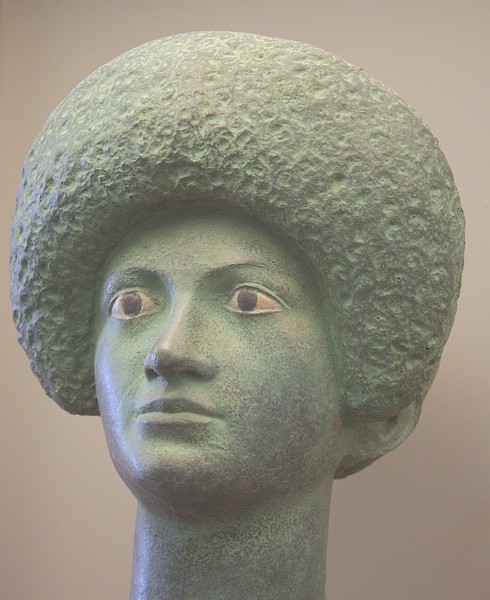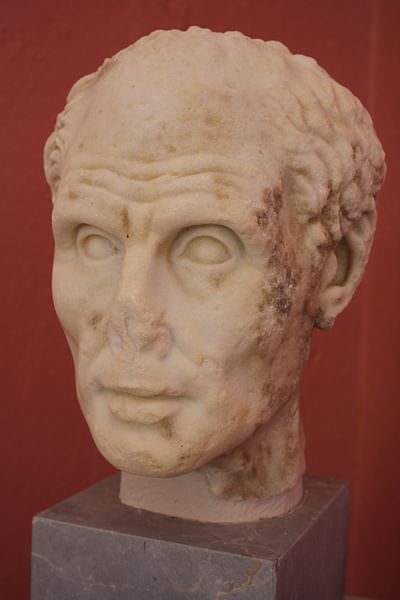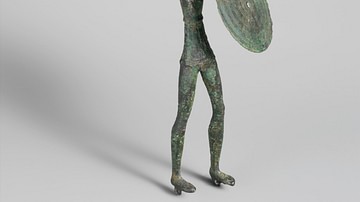
The Romans controlled such a vast empire for so long a period that a summary of the art produced in that time can only be a brief and selective one. Perhaps, though, the greatest points of distinction for Roman art are its very diversity, the embracing of art trends past and present from every corner of the empire and the promotion of art to such an extent that it became more widely produced and more easily available than ever before. In which other ancient civilization would it have been possible for a former slave to have commissioned his portrait bust? Roman artists copied, imitated, and innovated to produce art on a grand scale, sometimes compromising quality but on other occasions far exceeding the craftsmanship of their predecessors. Any material was fair game to be turned into objects of art. Recording historical events without the clutter of symbolism and mythological metaphor became an obsession. Immortalising an individual private patron in art was a common artist's commission. Painting aimed at faithfully capturing landscapes, townscapes, and the more trivial subjects of daily life. Realism became the ideal and the cultivation of a knowledge and appreciation of art itself became a worthy goal. These are the achievements of Roman art.
Art for All: Rome's Contribution
Roman art has suffered something of a crisis in reputation ever since the rediscovery and appreciation of ancient Greek art from the 17th century CE onwards. When art critics also realised that many of the finest Roman pieces were in fact copies or at least inspired by earlier and often lost Greek originals, the appreciation of Roman art, which had flourished along with all things Roman in the medieval and Renaissance periods, began to diminish. Another problem with Roman art is the very definition of what it actually is. Unlike Greek art, the vast geography of the Roman empire resulted in very diverse approaches to art depending on location. Although Rome long remained the focal point, there were several important art-producing centres in their own right who followed their own particular trends and tastes, notably at Alexandria, Antioch, and Athens. As a consequence, some critics even argued there was no such thing as 'Roman' art.
In more recent times a more balanced view of Roman art and a wider one provided by the successes of archaeology have ensured that the art of the Romans has been reassessed and its contribution to western art in general has been more greatly recognised. Even those holding the opinion that Classical Greek art was the zenith of artistic endeavour in the west or that the Romans merely fused the best of Greek and Etruscan art would have to admit that Roman art is nothing if not eclectic. Inheriting the Hellenistic world forged by Alexander the Great's conquests, with an empire covering a hugely diverse spectrum of cultures and peoples, their own appreciation of the past, and clear ideas on the best way to commemorate events and people, the Romans produced art in a vast array of forms. Seal-cutting, jewellery, glassware, mosaics, pottery, frescoes, statues, monumental architecture, and even epigraphy and coins were all used to beautify the Roman world as well as convey meaning from military prowess to fashions in aesthetics.
Artworks were looted from conquered cities and brought back for the appreciation of the public, foreign artists were employed in Roman cities, schools of art were created across the empire, technical developments were made, and workshops sprang up everywhere. Such was the demand for artworks, production lines of standardised and mass produced objects filled the empire with art. And here is another factor in Rome's favour, the sheer quantity of surviving artworks. Such sites as Pompeii, in particular, give a rare insight into how Roman artworks were used and combined to enrich the daily lives of citizens. Art itself became more personalised with a great increase in private patrons of the arts as opposed to state sponsors. This is seen in no clearer form than the creation of lifelike portraits of private individuals in paintings and sculpture. Like no other civilization before it, art became accessible not just to the wealthiest but also to the lower middle classes.
Key Art forms
Roman sculpture blended the idealised perfection of earlier Classical Greek sculpture with a greater aspiration for realism and mixed in the styles prevalent in Eastern art. Roman sculptors have also, with their popular copies of earlier Greek masterpieces, preserved for posterity invaluable works which would have otherwise been completely lost to world art.
The Romans favoured bronze and marble above all else for their finest work. However, as metal has always been in high demand for reuse, most of the surviving examples of Roman sculpture are in marble. The Roman taste for Greek and Hellenistic sculpture meant that once the supply of original pieces had been exhausted sculptors had to make copies, and these could be of varying quality depending on the sculptor's skills. Indeed, there was a school specifically for copying celebrated Greek originals in Athens and Rome itself. Roman sculptors also produced miniaturised copies of Greek originals, often in bronze, which were collected by art-lovers and displayed in cabinets in the home.
Roman sculpture did, however, begin to search for new avenues of artistic expression, moving away from their Etruscan and Greek roots, and, by the mid-1st century CE, Roman artists were seeking to capture and create optical effects of light and shade for greater realism. The realism in Roman portrait sculpture and funerary art may well have developed from the tradition of keeping realistic wax funeral masks of deceased family members in the ancestral home. Transferred to stone, we then have many examples of private portrait busts which sometimes present the subject as old, wrinkled, scarred, or flabby; in short, these portraits tell the truth. By later antiquity, there was even a move towards impressionism using tricks of light and abstract forms. Sculpture also became more monumental with massive, larger-than-life statues of emperors, gods, and heroes, such as the huge bronze statue of Marcus Aurelius on horseback now in the Capitoline Museum, Rome. Towards the end of the Empire, sculpture of figures tended to lack proportion, heads especially were enlarged, and figures were most often presented flatter and from the front, displaying the influence of Eastern art.
Sculpture on Roman buildings and altars could be merely decorative or have a more political purpose. For example, on triumphal arches the architectural sculpture captured in detail key campaign events, which reinforced the message that the emperor was a victorious and civilizing agent across the known world. A typical example is the Arch of Constantine in Rome (c. 315 CE) which also shows defeated and enslaved 'barbarians' to ram home the message of Rome's superiority. Such a portrayal of real people and specific historical figures in architectural sculpture is in marked contrast to Greek sculpture where great military victories were usually presented in metaphor, using figures from Greek mythology like amazons and centaurs such as on the Parthenon. Altars could also be used to present important individuals in a favourable light. The most famous altar of all is the Ara Pacis of Augustus (completed 9 BCE) in Rome, a huge block of masonry which depicts spectators and participants at a religious procession. It seems as though the figures have been captured in a single moment as in a photograph, a child pulls on a toga, Augustus' sister tells two chatterers to be silent, and so on.
Roman Wall Paintings
The interiors of Roman buildings of all description were very frequently sumptuously decorated using bold colours and designs. Wall paintings, fresco, and the use of stucco to create relief effects were all commonly used by the 1st century BCE in public buildings, private homes, temples, tombs, and even military structures across the Roman world. Designs could range from intricate realistic detail to highly impressionistic renderings which frequently covered all of the available wall space including the ceiling.
Roman wall painters (or perhaps their clients) preferred natural earth colours such as darker shades of reds, yellows, and browns. Blue and black pigments were also popular for plainer designs, but evidence from a Pompeii paint shop illustrates that a wide range of colour shades was available. Subjects could include portraits, scenes from mythology, architecture using trompe-l'oeil, flora, fauna, and even entire gardens, landscapes and townscapes to create spectacular 360° panoramas which transported the viewer from the confines of a small room to the limitless world of the painter's imagination. An outstanding example is the 1st century BCE House of Livia on the Palatine hill in Rome which includes a 360° panorama of an impressionistically rendered garden. The scene runs around one room and completely ignores the corners. Another splendid example is the 1st century CE private villa known as the House of the Vettii in Pompeii.
As the art form developed, larger-scale single scenes which presented larger-than-life figures became more common. By the 3rd century CE one of the best sources of wall painting comes from Christian catacombs where scenes were painted from both the Old and New Testament.
Roman mosaics were a common feature of private homes and public buildings across the empire from Africa to Antioch. Mosaics, otherwise known as opus tessellatum, were made with small black, white, and coloured squares of marble, tile, glass, pottery, stone, or shells. Typically, each individual piece measured between 0.5 and 1.5 cm but fine details, especially in the central panel (emblemata) were often rendered using even smaller pieces as little as 1mm in size. Designs employed a wide spectrum of colours with coloured grouting to match surrounding tesserae. This particular type of mosaic which used sophisticated colouring and shading to create an effect similar to a painting is known as opus vermiculatum, and one of its greatest craftsmen was Sorus of Pergamon (150-100 BCE) whose work, especially his Drinking Doves mosaic, was much copied for centuries after.
Popular subjects included scenes from mythology, gladiator contests, sports, agriculture, hunting, food, flora and fauna, and sometimes they even captured the Romans themselves in detailed and realistic portraits. One the most famous Roman mosaics today is one from the House of the Faun, Pompeii, which depicts Alexander the Great riding Bucephalus and facing Darius III on his war chariot. Not just floors but also vaults, columns, and fountains were decorated with mosaic designs too.
Roman mosaics artists developed their own styles, and production schools were formed across the empire which cultivated their own particular preferences - large-scale hunting scenes and attempts at perspective in the African provinces, impressionistic vegetation and a foreground observer in the mosaics of Antioch, or the European preference for figure panels, for example. The dominant (but not exclusive) Roman style in Italy itself used only black and white tesserae, a taste which survived well into the 3rd century CE and was most often used to represent marine motifs, especially when used for Roman baths. Over time the mosaics became ever more realistic in their portrayal of human figures, and accurate and detailed portraits become more common. Meanwhile, in the Eastern part of the empire and especially at Antioch, the 4th century CE saw the spread of mosaics which used two-dimensional and repeated motifs to create a 'carpet' effect, a style which would heavily influence later Christian churches and Jewish synagogues.
Minor Arts
The minor arts of ancient Rome were wide and varied, illustrating in many cases the Roman love of finely worked precious materials with detail and often miniaturised designs. They included jewellery of all kinds, small gold portrait busts, silverware such as mirrors, cups, plates, figurines etc., gem-cutting and engraving, sardonyx cameos, seals, vessels and ornaments in cut-glass, inlaid, gilded or enamelled bronze vessels, carved and engraved ivories, fine decorated pottery, plaques for addition to furniture, elements of military uniforms and weapons, medallions, coins, terracotta oil lamps, embroidered Tyrian purple cloth, and illustrated books. Subjects of decoration included the imperial family, private individuals, mythology, nature, and such standard motifs as geometrical shapes, acanthus leaves, vines, meanders, rosettes, and swastikas. Works are often signed by the craftsman, who may be foreign or Roman.

Items of silverware and carved gems were especially appreciated and frequently collected by those Romans who could afford them. Kept in the home, they would, no doubt, have been shown to admiring visitors and used as conversation pieces. The Roman love for intricately detailed and tiny carvings on gems counters the traditional view that Roman art was preoccupied with all that was massive and inelegantly bulky. Signet rings, a symbol of family pride and an important method of signature along with seal-stones, were, like gemstones, carved using small drills with a diamond point or lap-wheel which were rotated using a horizontal bow on the shaft. Cornelian and onyx seem to have been the material of choice for more functional items, but sapphires and aquamarine are amongst the more precious gems the Romans imported from such far-flung places as India.
Roman jewellers were especially skilled in their craft. Learning from those who had gone before, they employed the full range of metalworking skills such as gilding, granulation, repousse, inlay, open-work etc. Rings, necklaces, bracelets, brooches, buckles, earrings, pendants, anklets, and hair nets were all produced in precious metals, often with extraordinary detail and craftsmanship. As time went on, jewellery generally became heavier and more flashy and was by no means limited to women's dress.
Legacy
In many ways, the Romans continued and perpetuated the arts of earlier civilizations, but as the art historian Martin Henig here summarises, their artistic efforts came to much more than that:
Roman achievement…totally belies the philistine reputation that has been popularly ascribed to ancient Rome. Inheriting the Greek traditions, Roman craftsmen continued to innovate, and their work never ceases to astonish us by its delicacy of form. (Henig, 165)
Contributions from Roman art to the general development of western art include a determination to record actual historical events; wall paintings in different styles which captured the architecture of the day, natural views or still life - including people and ordinary objects which were rarely previously depicted in art; and realistic portraiture of humble citizens. None of these was wholly new in art but the Romans, as in so many other fields, pushed the possibilities of an idea to its limits and beyond.
By the end of the Roman period new ideas in art were developing and would continue to do so, but Roman art would have a lasting effect on all who followed, not least in medieval Christian art and drawings on manuscripts. Perhaps, though, their greatest contribution to world art was the fostering of the idea that the appreciation of art for its own sake was a fine thing and that to possess art objects or even a collection was a real badge of one's cultural sophistication. In addition, even for those who could not afford their own art, there was the provision of public art galleries. Art was no longer the exclusive domain of the rich, art was for anyone and everyone. The Romans, like no other culture before them, were champions of art as a popular, affordable, and accessible means of expressing and communicating the human spirit.











